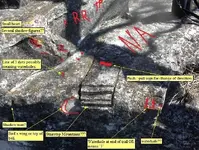Texas Jay
Bronze Member
- Joined
- Feb 11, 2006
- Messages
- 1,152
- Reaction score
- 1,363
- Golden Thread
- 0
- Location
- Brownwood, Texas
- Detector(s) used
- Garrett AT Pro, Garrett Scorpion Gold Stinger, Garrett Ace 350, Garrett Ace 250, vintage D-Tex SK 70, Tesoro Mojave, Dowsing Rods
- Primary Interest:
- All Treasure Hunting
I'd never noticed the shadow face before you guys noticed it. So cool! I have a lot to learn about deciphering signs and symbols so I really appreciate your comments based on your experience. The bear is on a rock on the face of a cliff and, to the left side of it (west) only a few yards away, we found these three horseshoes (muleshoes?) on a large slab of the same type of rock that is laying flat on the ground. The rock on this site is very hard and not easy to carve in so these more intricate carvings probably took several hours and the right equipment to create. The bronze token is one of my sobriety chips and is about the size of a silver dollar. I placed it there for size comparison purposes. I also outlined the carvings that I could clearly make out in white chalk.
~Texas Jay
~Texas Jay





 It is probable that the Spanish used this site as a landmark as others, including the KGC, did a few hundred years later.
It is probable that the Spanish used this site as a landmark as others, including the KGC, did a few hundred years later.  It might. I am no expert and am only quoting from Kenworthy's book about the letter "W". He does mention that the Spanish and, later, the Mexicans, used Roman Numerals on their maps and trail markers and the letter "M" is one of them.
It might. I am no expert and am only quoting from Kenworthy's book about the letter "W". He does mention that the Spanish and, later, the Mexicans, used Roman Numerals on their maps and trail markers and the letter "M" is one of them.





 The dime novel writers "invented her" just like they did Wyatt Earp and Buffalo Bill Cody.
The dime novel writers "invented her" just like they did Wyatt Earp and Buffalo Bill Cody.